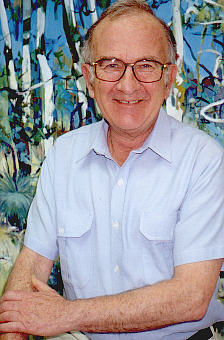
 |
| Garden pioneer: Dr Gavan Oakley's idea was inspired by the popular United Kingdom garden allotment scheme. |
He believed older members of the community could use the expertise to teach young people about
gardening.
"The concept of the community gardens would bring the expertise of older people and pass it
on to younger tenants - something useful to do, " he said.
Initially the scheme struck a hitch when Nunawading Council expressed reluctance to spend a great
deal of money to get it going, Dr Oakley said, but this problem was overcome when it was suggested
that vacant land behind the then proposed Nunawading Horticultural Centre would be ideal for the
purpose.
Once the committee was formed it "went on its own steam", Dr Oakley said.
"It became overwhelmingly popular."
Nunawading ratepayers and residents readily accepted the invitation to apply for the 65 four
metre by nine metre garden allotments which were allocated by the ceremonial drawing of metal tags
printed with plot numbers.
The plots were offered on a one-year renewable lease at a cost of $22 plus a $3 membership fee.
Avid gardeners, housewives, professionals, young people and those who just liked pottering around the
garden were among those drawn by the lure of sunshine and the opportunity for a chat.
Many residents of the treed Blackburn Lake area where shaded native gardens precluded the
successful propagation of vegetables and colourful flowers were among the first wave of communal gardeners.
Dr Oakley summed up the garden's wide appeal as the companionship of "people talking to one
another" generated by a mutual interest, the opportunity for people to overcome loneliness, and
the satisfaction derived by all involved.
It attracted a cross-section of the community, which he described as "family oriented" and "fairly
international".
Although Dr Oakley instigated the concept of the gardens, he never had the opportunity to enjoy the
fruits of his efforts.
After the garden was established, he resigned as a councillor and moved with his family to a
farm in Yarra Glen.
"I had the idea but no plot. My plot was to get it going," he said.
"If I ever moved back I'd get one for sure."
Since the gardens at Nunawading were established, other municipalities picked up on the idea, he said.
"It was a bit of history-making.
"I doubt whether under the commissioners system a thing like that would get off the ground".
Former Nunawading mayor and councillor Wendy Reid had just been elected to council in 1977 when the concept
of a community garden for Nunawading was raised by Dr Oakley.
"He appreciated the social and community significance of the community gardens," Mrs Reid said.
She was speaking to the Gazette from her Glenburn home, where she has lived since 1992.
Although it "proved to be a very successful option for people to get together", Mrs Reid said it was
"politically difficult initially".
"The officers of the council weren't particularly enamoured with the initiative."
However, she said the Nunawading Community Gardens' committee was formed after a public meeting
which showed community interest.
"Gavan (Oakley) certainly has to have credit for introducing the idea to Nunawading.
"I was left with seeing the idea was successful."
Mrs Reid said there was "no suggestion the garden would fall into rack and ruin."
She remembered the committee as "a very happy recreational club" committed and dedicated to
the task.
"An excellent group of people were involved initially," she said.
Mrs Reid, who with her husband Alan, tended a plot for 13 years, said the community gardens
were self-sustaining and thrived on the activities of those involved.
The council provided an initial grant of $5000 for a shed, fence posts, taps, pipes, and ploughing of the land.
Plot owners would exchange flowers and vegetables, and the working bees were very well attended, she said.
'The council never had to do anything for the group."
Mrs Reid said it was "absolutely marvellous" the gardens had survived for 18 years.
"It was a good venture"
Mrs Rackham believed the strength of the garden's success was the appeal of "nice open land" and the "open sunshine you don't get in local backyards".
She said she "liked pottering around the garden but had bad luck with vegetables" because there
were too many trees in her backyard.
The people working the plots over the years reflected an eclectic mix of cultures including Dutch,
Italian, Greek, and various Asian nationalities including Vietnamese and Chinese.
"We are all starting to learn new things," Mrs Rackham said.
"We learnt so much from other people and cultures."
Mrs Rackham's involvement with the Nunawading Community Gardens started when she read an item in the
Nunawading Gazette in June 1977 calling for people interested in gardening
plots.
She later became a steering committee member and started the organisations quarterly newsletter.
The newsletter started as a source of information for members but has now expanded to include gardening issues and tips and contributions
from members such as recipes.
Mrs Rackham, who edited the newsletter for more than six years, said it helped shape the view that pesticides
would be banned from use in the gardens - a view which later was introduced as one of the committee's
by-laws.
She said judging by the enthusiasm of people she "never doubted the gardens would keep going"
After October 1977, demand for plots was so great the committee applied for more land from the council
and more than 50 new plots were added to the initial 65.
 |
| Tilling the earth:
Phyl Ward and Margaret Rackham enjoy working with the rich, brown soil at the community gardens. picture: COLIN STUCKY
|